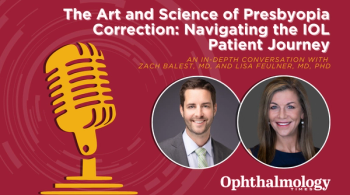
Dye decreases challenges of sutureless corneal transplant
Sutureless corneal transplantation surgery is sufficiently challenging in and of itself, so any improvement in the technique that lowers the rate of reoperation because of a poorly positioned donor disc or disc detachment is worthy of discussion.
Instilling a drop of indocyanine green (ICG) (IC-Green, Akorn) or trypan blue 0.1% (Vision Blue, Dutch Ophthalmic Research Co.), the latter of which is newly approved by the FDA, on the donor corneal stroma makes visualization and positioning of the tissue markedly easier. This in turn facilitates proper centration, augments visualization of the host-donor interface, and facilitates decreasing or elimination of any interface air bubbles, and thus, lowers the need for a second surgery to adjust the position of the grafted tissue or reattachment of a detached disc.
A disposable trephine (Moria) with a diameter based on surgeon preference is used in a guillotine fashion to punch the donor disc. The donor disc is then folded in a manner resembling a taco. The surface of the taco is either blue or green depending on which dye was used.
Air is then used to unfold the taco inside the anterior chamber. If the donor disc is not properly centered after it is unfolded, it can be moved easily into position onto the host inner corneal surface with a reverse Sinskey hook over an air bubble.
Newsletter
Don’t miss out—get Ophthalmology Times updates on the latest clinical advancements and expert interviews, straight to your inbox.
















































.png)


